Dopant Concentration Induced Optical Changes in Ca,Eu-α-Sialon
Abstract
:1. Introduction
2. Experimental
3. Results
3.1. Physico-Chemical Characterization
3.2. Basic Spectroscopy
3.3. Time Resolved Spectroscopy
3.4. High Pressure Spectroscopy
4. Conclusions
Acknowledgments
Author Contributions
Conflicts of Interest
References
- Xie, R.J.; Hirosaki, N. Silicon-based oxynitride and nitride phosphors for white LEDs-A review. Sci. Technol. Adv. Mater. 2007, 8, 588–600. [Google Scholar] [CrossRef]
- Ye, S.; Xiao, F.; Pan, Y.X.; Ma, Y.Y.; Zhang, Q.Y. Phosphors in phosphor-converted white light-emitting diodes: Recent advances in materials, techniques and properties. Mater. Sci. Eng. R 2010, 71, 1–34. [Google Scholar] [CrossRef]
- Xie, R.J.; Hirosaki, N.; Takeda, T. Highly reliable white LEDs using nitride phosphors. J. Korean Ceram. Soc. 2012, 49, 375–379. [Google Scholar] [CrossRef]
- Xie, R.J.; Hintzen, H.T. Optical properties of (oxy)nitride materials: A review. J. Am. Ceram. Soc. 2013, 96, 665–687. [Google Scholar] [CrossRef]
- Xia, Z.; Xu, Z.; Chen, M.; Liu, Q. Recent developments in the new inorganic solid state LED phosphors. Dalton Trans. 2016, 45, 11214–11232. [Google Scholar] [CrossRef] [PubMed]
- Van Krevel, J.W.H.; Van Rutten, J.W.T.; Mandal, H.; Hintzen, H.T.; Metselaar, R. Luminescence properties of terbium-, cerium-, or europium-doped α-sialon materials. J. Solid State Chem. 2002, 165, 19–24. [Google Scholar] [CrossRef]
- Xie, R.; Mitomo, M.; Uheda, K.; Xu, F.-F.; Akimune, Y. Preparation and luminescence spectra of calcium-and rare-earth (R = Eu, Tb, and Pr)-Codoped α-SiAlON ceramics. J. Am. Ceram. Soc. 2002, 85, 1229–1234. [Google Scholar] [CrossRef]
- Hirosaki, N.; Xie, R.J.; Kimoto, K.; Sekiguchi, T.; Yamamoto, Y.; Suehiro, T.; Mitomo, M. Characterization and properties of green-emitting b-SiAlON: Eu2+ powder phosphors for white light-emitting diodes. Appl. Phys. Lett. 2005, 86, 211905. [Google Scholar] [CrossRef]
- Bachmann, V.; Ronda, C.; Oeckler, O.; Schnick, W.; Meijerink, A. Color point tuning for (Sr,Ca,Ba)Si2O2N2:Eu2+ for white light LEDs. Chem. Mater. 2009, 21, 316–325. [Google Scholar] [CrossRef]
- Li, Y.Q.; de With, G.; Hintzen, H.T. The effect of replacement of Sr by Ca on the structural and luminescence properties of the red-emitting Sr2Si5N8:Eu2+ LED conversion phosphor. J. Solid State Chem. 2008, 181, 515–524. [Google Scholar] [CrossRef]
- Li, Y.Q.; Hirosaki, N.; Xie, R.-J.; Takada, T.; Yamamoto, Y.; Mitomo, M.; Shioi, K. Synthesis, crystal and local electronic structures, and photoluminescence properties of red-emitting CaAlzSiN2+z:Eu2+ with orthorhombic structure. Int. J. Appl. Ceram. Technol. 2010, 7, 787–802. [Google Scholar] [CrossRef]
- Li, Y.Q.; Delsing, A.C.A.; De With, G.; Hintzen, H.T. Luminescence properties of Eu2+-activated alkaline-earth silicon-oxynitride MSi2O2-δN2+2/3δ (M = Ca, Sr, Ba): A promising class of novel LED conversion phosphors. Chem. Mater. 2005, 17, 3242–3248. [Google Scholar] [CrossRef]
- Search, H.; Journals, C.; Contact, A.; Iopscience, M.; Address, I.P. Luminescence properties of SrSi6N8:Eu2+. J. Mater. Sci. 2012, 75502, 2–7. [Google Scholar]
- Xie, R.J.; Hirosaki, N.; Sakuma, K.; Yamamoto, Y.; Mitomo, M. Eu2+-doped Ca-α-SiAlON: A yellow phosphor for white light-emitting diodes. Appl. Phys. Lett. 2004, 84, 5404. [Google Scholar] [CrossRef]
- Suehiro, T.; Hirosaki, N.; Xie, R.J.; Mitomo, M. Powder synthesis of Ca-α′-SiAlON as a host material for phosphors. Chem. Mater. 2005, 17, 308–314. [Google Scholar] [CrossRef]
- Xie, R.J.; Hirosaki, N.; Mitomo, M.; Suehiro, T.; Xu, X.; Tanaka, H. Photoluminescence of rare-earth-doped Ca-α-SiAlON phosphors: Composition and concentration dependence. J. Am. Ceram. Soc. 2005, 88, 2883–2888. [Google Scholar] [CrossRef]
- Li, H.L.; Hirosaki, N.; Xie, R.J.; Suehiro, T.; Mitomo, M. Fine yellow alpha-SiAlON:Eu phosphors for white LEDs prepared by the gas-reduction-nitridation method. Sci. Technol. Adv. Mater. 2007, 8, 601–606. [Google Scholar] [CrossRef]
- Suehiro, T.; Hirosaki, N.; Xie, R.J.; Sakuma, K.; Mitomo, M.; Ibukiyama, M.; Yamada, S. One-step preparation of Ca-alpha-SiAlON:Eu2+ fine powder phosphors for white light-emitting diodes. Appl. Phys. Lett. 2008, 92, 191904. [Google Scholar] [CrossRef]
- Cao, G.Z.; Metselaar, R. Alpha’-Sialon Ceramics—A Review. Chem. Mater. 1991, 3, 242–252. [Google Scholar] [CrossRef]
- Ekström, T.; Nygren, M. SiAION Ceramics. J. Am. Ceram. Soc. 1992, 75, 259–276. [Google Scholar] [CrossRef]
- Izumi, F.; Mitomo, M.; Suzuki, J. Structure refinement of yttrium α-sialon from X-ray powder profile data. J. Mater. Sci. Lett. 1982, 1, 533–535. [Google Scholar] [CrossRef]
- Li, Y.Q.; Hirosaki, N.; Xie, R.-J.; Takeda, T.; Mitomo, M. Photoluminescence properties of rare earth doped α-Si3N4. J. Lumin. 2010, 130, 1147–1153. [Google Scholar] [CrossRef]
- Wu, Q.; Ding, J.; Wang, X.; Li, Y.; Wang, Y. Structure modification and covalence variation induced by cation substitution in pure nitride Ca-α-sialon phosphor. Mater. Res. Bull. 2016, 83, 649–656. [Google Scholar] [CrossRef]
- Shioi, K.; Hirosaki, N.; Xie, R.-J.; Takeda, T.; Li, Y.Q. Synthesis, crystal structure and photoluminescence of Eu-α-SiAlON. J. Alloy. Compd. 2010, 504, 579–584. [Google Scholar] [CrossRef]
- Shioi, K.; Hirosaki, N.; Xie, R.-J.; Takeda, T.; Li, Y.Q.; Matsushita, Y. Synthesis, crystal structure, and photoluminescence of Sr-α-SiAlON:Eu2+. J. Am. Ceram. Soc. 2010, 93, 465–469. [Google Scholar] [CrossRef]
- Redington, M.; O’Reilly, K.; Hampshire, S. On the relationships between composition and cell dimensions in alpha-sialons. J. Mater. Sci. Lett. 1991, 10, 1228–1231. [Google Scholar] [CrossRef]
- Van Rutten, J.W.T.; Hintzen, H.T.; Metselaar, R. Phase formation sintering of Ca-alpha-sialon by reaction sintering. J. Eur. Ceram. Soc. 1996, 16, 995–999. [Google Scholar] [CrossRef]
- Mandal, H. New developments in -SiAlON ceramics. J. Eur. Ceram. Soc. 1999, 19, 2349–2357. [Google Scholar] [CrossRef]
- Huang, Z.K.; Tien, T.Y. Solid-liquid reaction in the system Si3N4-Y3Al5O12-Y2Si2O7 under 1 MPa of nitrogen. J. Am. Ceram. Soc. 1994, 77, 2763–2766. [Google Scholar] [CrossRef]
- Xu, X.; Tang, J.; Nishimura, T.; Hao, L. Synthesis of Ca-alpha-SiAlON phosphors by a mechanochemical activation route. Acta Mater. 2011, 59, 1570–1576. [Google Scholar] [CrossRef]
- Becher, P.F.; Painter, G.S.; Shibata, N.; Satet, R.L.; Hoffmann, M.J.; Pennycook, S.J. Influence of additives on anisotropic grain growth in silicon nitride ceramics. Mater. Sci. Eng. A 2006, 422, 85–91. [Google Scholar] [CrossRef]
- Jiang, J.; Wang, P.; He, W.; Chen, W.; Zhuang, H.; Cheng, Y.; Yan, D. Self-propagating high-temperature synthesis of alpha-SiAlON doped by RE (RE = Eu, Pr, Ce) and codoped by RE and Yttrium. J. Am. Ceram. Soc. 2004, 87, 703–705. [Google Scholar] [CrossRef]
- Sakuma, K.; Hirosaki, N.; Xie, R.J. Red-shift of emission wavelength caused by reabsorption mechanism of europium activated Ca-α-SiAlON ceramic phosphors. J. Lumin. 2007, 126, 843–852. [Google Scholar] [CrossRef]
- Wu, Q.; Wang, Y.; Yang, Z.; Que, M.; Li, Y.; Wang, C. Synthesis and luminescence properties of pure nitride Ca-α-sialon with the composition Ca1.4Al2.8Si9.2N16 by gas-pressed sintering. J. Mater. Chem. C 2014, 2, 829–834. [Google Scholar] [CrossRef]
- Park, W.J.; Song, Y.H.; Moon, J.W.; Kang, S.M.; Yoon, D.H. Synthesis and luminescent properties of Eu2+ doped nitrogen-rich Ca-alpha-SiAlON phosphor for white light-emitting diodes. Solid State Sci. 2010, 12, 1853–1856. [Google Scholar] [CrossRef]
- Piao, X.; Machida, K.; Horikawa, T.; Hanzawa, H. Synthesis and luminescent properties of low oxygen contained Eu2+-doped Ca-α-SiAlON phosphor from calcium cyanamide reduction. J. Rare Earth. 2008, 26, 198–202. [Google Scholar] [CrossRef]
- Yang, Z.; Wang, Y.; Zhao, Z. Synthesis, structure and photoluminescence properties of fine yellow-orange Ca-α-SiAlON: Eu2+ phosphors. J. Alloy. Compd. 2012, 541, 70–74. [Google Scholar] [CrossRef]
- Sakuma, K.; Hirosaki, N.; Xie, R.J.; Yamamoto, Y.; Suehiro, T. Optical properties of excitation spectra of (Ca,Y)-alpha-SiAlON:Eu yellow phosphors. Physica Status Solidi C Conf. 2006, 3, 2701–2704. [Google Scholar] [CrossRef]
- Sakuma, K.; Hirosaki, N.; Xie, R.J.; Yamamoto, Y.; Suehiro, T. Luminescence properties of (Ca,Y)-alpha-SiAlON:Eu phosphors. Mater. Lett. 2007, 61, 547–550. [Google Scholar] [CrossRef]
- Park, S.S.; Jang, B.Y.; Park, J.S.; Nahm, S. Crystal structures and luminescence properties of AlN-deficient Eu2+—Activated Ca-alpha-SiAlON phosphor. J. Korean Phys. Soc. 2010, 57, 990–993. [Google Scholar]
- Pawlik, T.; Michalik, D.; Sopicka-Lizer, M.; Lisiecki, R.; Adamczyk, B.; Pławecki, M.; Mieszczak, Ł.; Walerczyk, W. Luminescence properties of the Ca-alpha-sialon:Eu solid solution. Opt. Mater. 2016, 59, 43–48. [Google Scholar] [CrossRef]
- Pawlik, T.; Michalik, D.; Sopicka-Lizer, M.; Serkowski, S. Influence of m and n parameters of Ca- α-sialon: Eu solid solution on phosphor’s optical properties. Adv. Sci. Technol. 2014, 90, 149–156. [Google Scholar] [CrossRef]
- Chung, C.-C.; Jean, J.-H. Synthesis of Ca-α-SiAlON:Eux phosphor powder by carbothermal-reduction–nitridation process. Mater. Chem. Phys. 2010, 123, 13–15. [Google Scholar] [CrossRef]
- Cho, E.-J.; Oh, S.-J. Surface valence transition in trivalent Eu insulating compounds observed by photoelectron spectroscopy. Phys. Rev. B 1999, 59, 15613–15616. [Google Scholar] [CrossRef]
- Burian, W.; Szade, J.; O’Keevan, T.; Celiński, Z. Photoemission study of Eu valency in EuF3 ultrathin buried layers and single crystals. Phys. Status Solidi B 2004, 241, R15–R18. [Google Scholar] [CrossRef]
- Dhoble, S.J.; Nagpure, I.M.; Dhoble, N.S.; Molina, P. Effect of Bi ion on Eu2+ ↔ Eu3+ conversion in CaF2:Eu phosphors for RPL dosimetry. J. Mater. Sci. 2011, 46, 7253–7261. [Google Scholar] [CrossRef]
- Gao, G.; Reibstein, S.; Peng, M.; Wondraczek, L. Tunable dual-mode photoluminescence from nanocrystalline Eu-doped Li2ZnSiO4 glass ceramic phosphors. J. Mater. Chem. 2011, 21, 3156. [Google Scholar] [CrossRef]
- Maślankiewicz, P.; Szade, J.; Winiarski, A.; Daniel, P. Bridgman-Stockbarger growth and X-ray photoelectron spectroscopy study of LiY1-xEuxF4 crystals. Cryst. Res. Technol. 2005, 40, 410–418. [Google Scholar] [CrossRef]
- Pawlik, T.; Michalik, D.; Sopicka-Lizer, M.; Lisiecki, R. Effect of AlF3 and HBO3 fluxes on the structure and optical properties of Ca-α-sialon:Eu2+ phosphor powders. Inżynieria Materiałowa 2016, 37, 35–40. [Google Scholar]
- Shannon, R.D. Revised effective ionic radii and systematic studies of interatomic distances in halides and chalcogenides. Acta Crystallogr. A 1976, 32, 751–767. [Google Scholar] [CrossRef]
- Mezzi, A.; Kaciulis, S.; Cacciotti, I.; Bianco, A.; Gusmano, G.; Lamastra, F.R.; Fragalà, M.E. Structure and composition of electrospun titania nanofibres doped with Eu. Surf. Interface Anal. 2010, 42, 572–575. [Google Scholar] [CrossRef]
- Vercaemst, R.; Poelman, D.; Van Meirhaeghe, R.L.; Fiermans, L.; Laflère, W.H.; Cardon, F. An XPS study of the dopants’ valence states and the composition of CaS1−xSex:Eu and SrS1−xSex:Ce thin film electroluminescent devices. J. Lumin. 1995, 63, 19–30. [Google Scholar] [CrossRef]
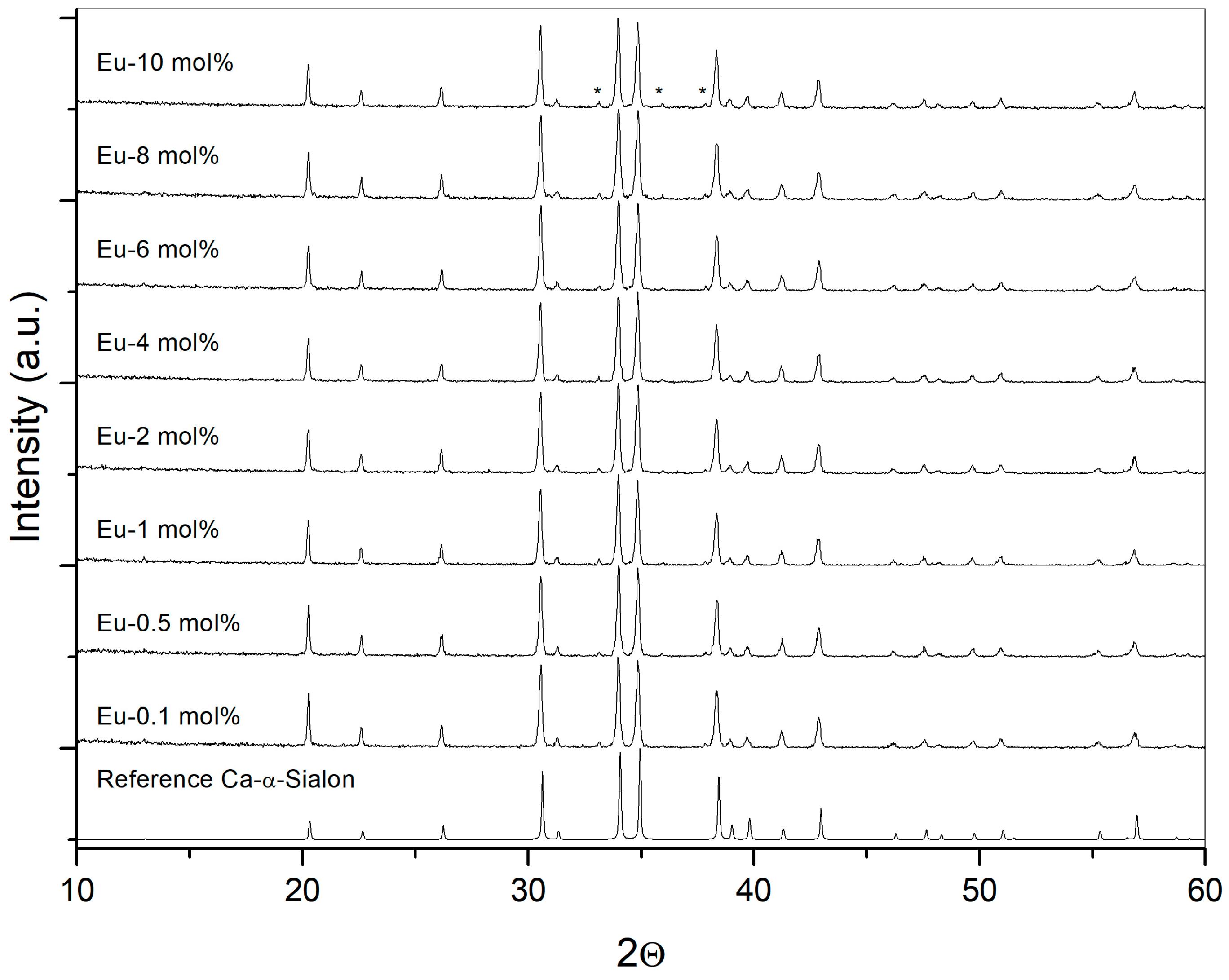

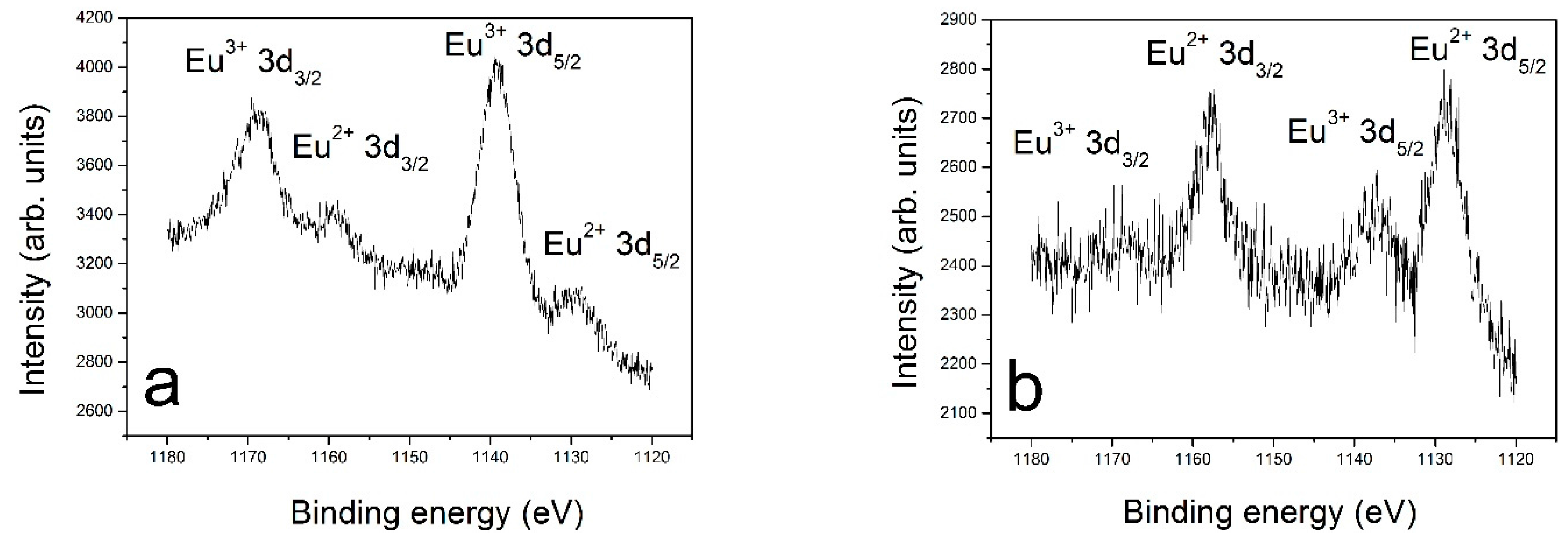

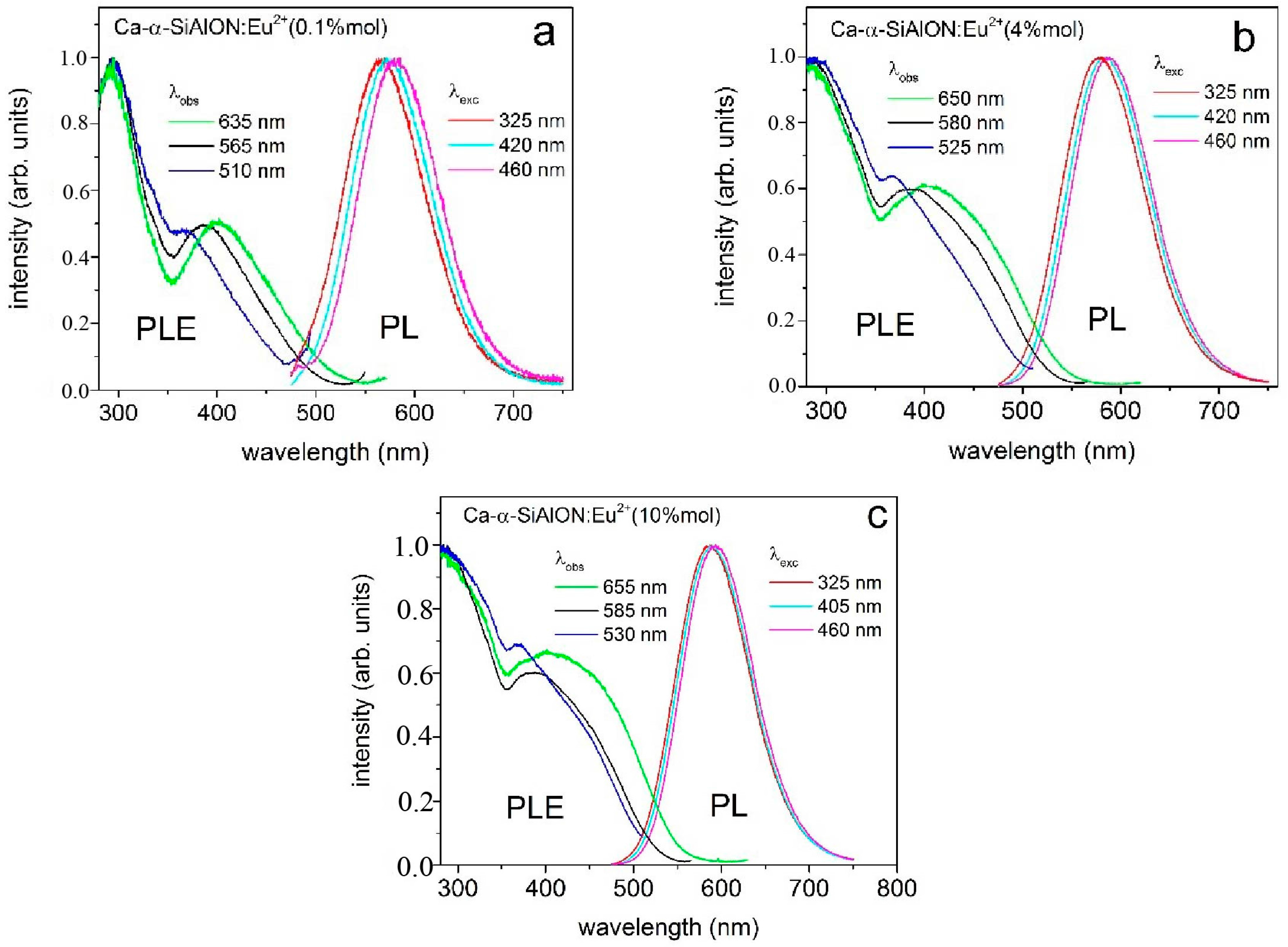


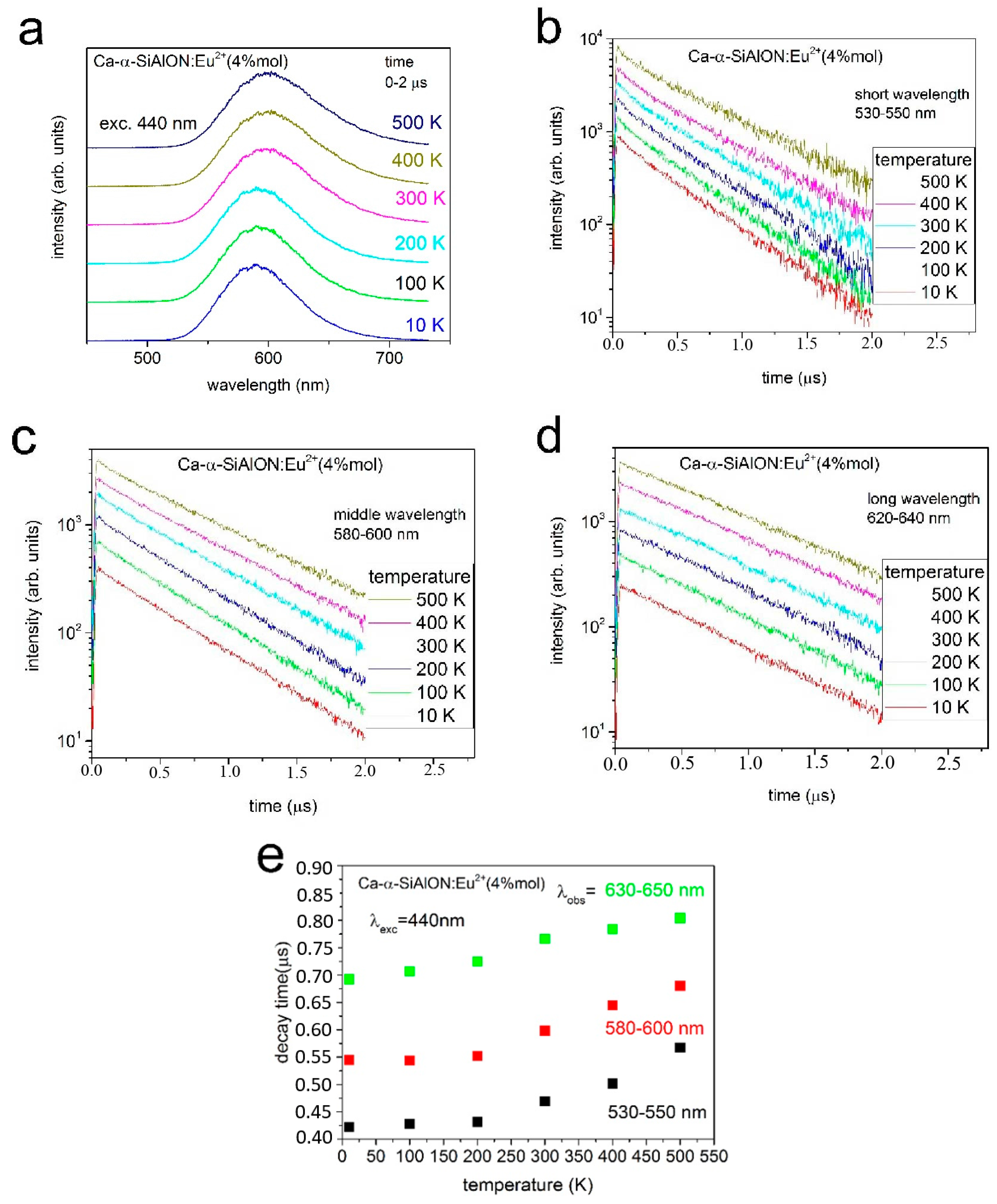
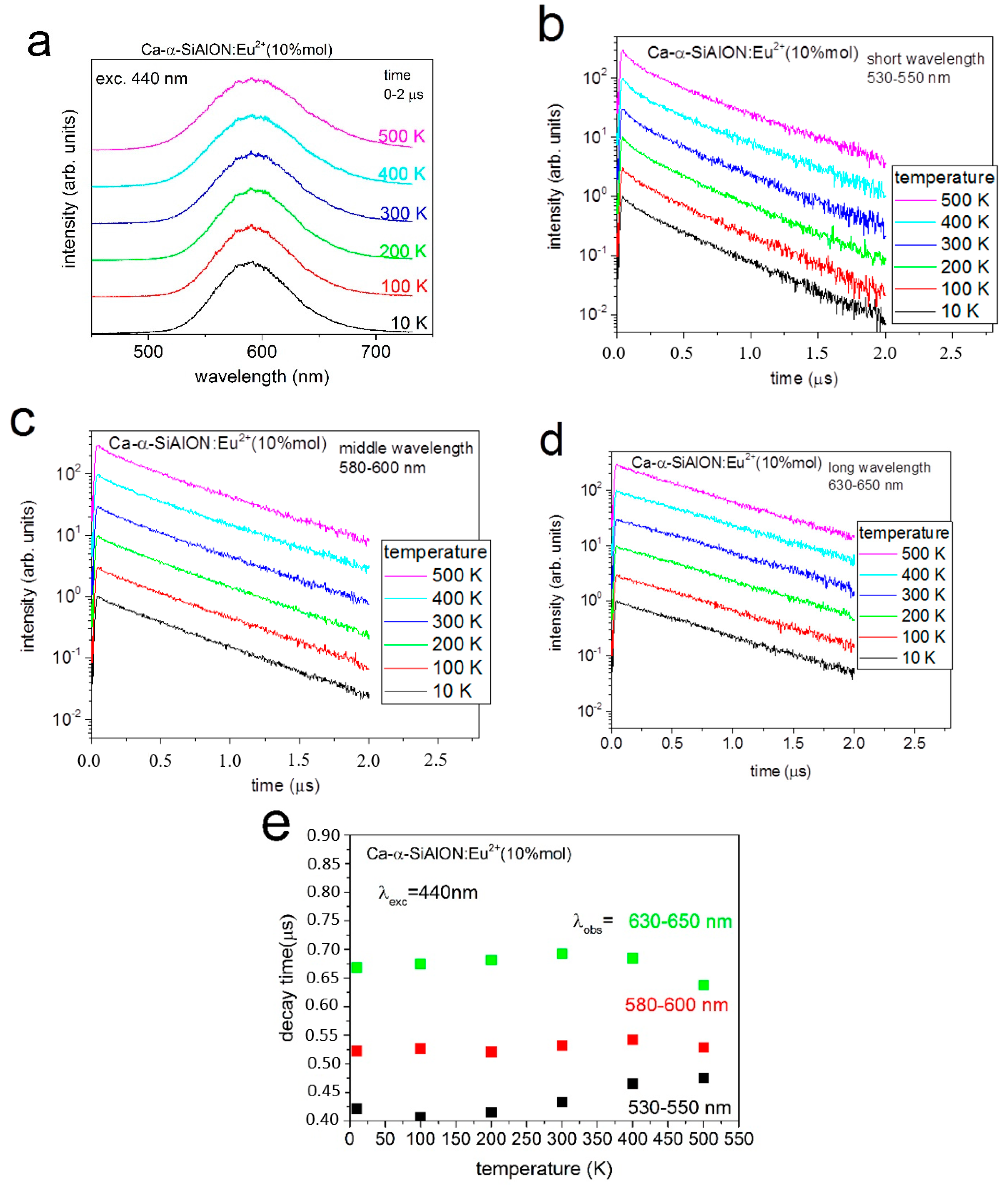
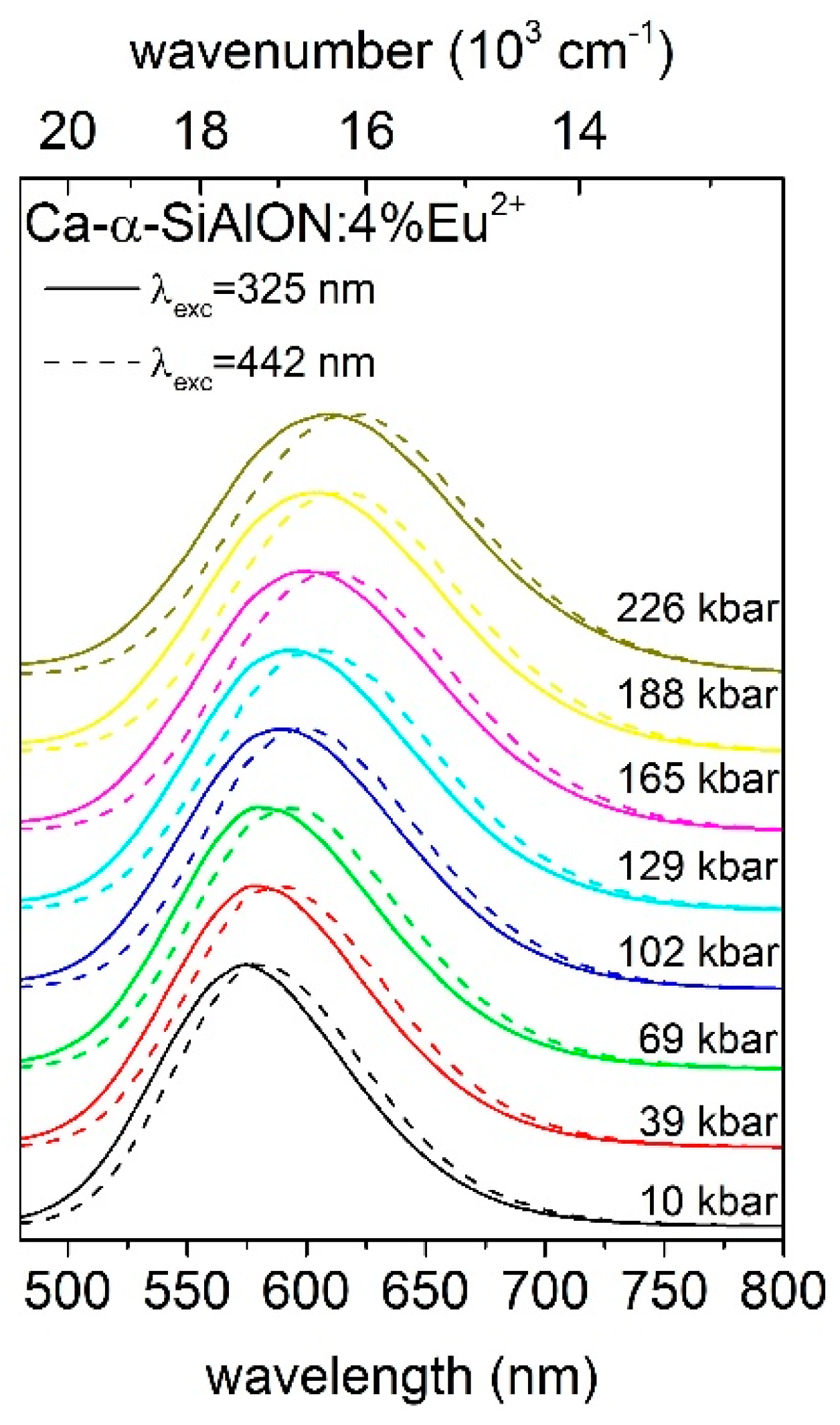


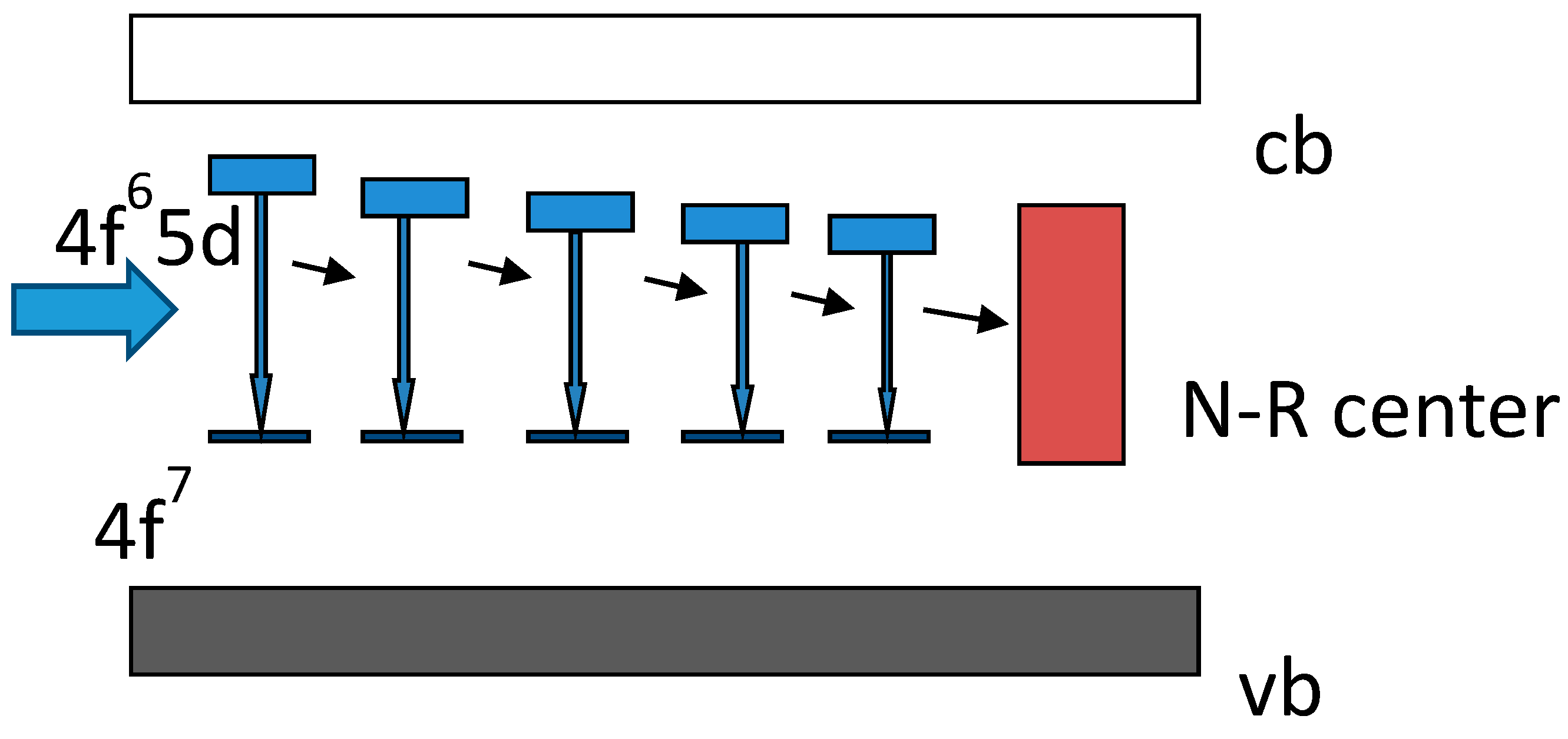
| Eu [at %] | Phase Composition [wt %] | Unit Cell [Å] | Volume [Å3] | Crystallite Size [nm] | ||
|---|---|---|---|---|---|---|
| Ca-α-sialon | AlN | a | c | |||
| REF | 7.838(0) | 5.703(0) | 350.3595 | |||
| 0.1 | 98.4 | 1.6 | 7.840(5) | 5.701(3) | 350.4785 | 74 ± 1 |
| 2 | 98.4 | 1.6 | 7.842(2) | 5.702(6) | 350.7105 | 67 ± 1 |
| 4 | 98.6 | 1.4 | 7.842(1) | 5.702(9) | 350.7200 | 69 ± 1 |
| 6 | 98.0 | 2.0 | 7.843(5) | 5.704(7) | 350.9560 | 60 ± 1 |
| 8 | 98.0 | 2.0 | 7.842(9) | 5.704(2) | 350.8715 | 59 ± 1 |
| 10 | 97.9 | 2.4 | 7.841(1) | 5.703(1) | 350.6428 | 71 ± 1 |
| Specimen | Chemical Composition Mol % | Ca/Al Molar Ratio | |||
|---|---|---|---|---|---|
| Eu | Ca | Si | Al | ||
| designed | 0.01 | 6.24 | 75 | 18.75 | 0.333 |
| Eu-0.1 mol % | 0 | 8.1 ± 0.4 | 75.7 ± 0.6 | 16.2 ± 0.8 | 0.5 |
| designed | 0.25 | 6 | 75 | 18.75 | 0.32 |
| Eu-4 mol % | 0.33 ± 0.15 | 7.7 ± 1.0 | 75 ± 0.9 | 16.9 ± 1.3 | 0.45 |
| Eu-4 mol %/XPS | 2.45 | 6.1 | 71.8 | 19.6 | 0.31 |
| designed | 0.63 | 5.63 | 75 | 18.75 | 0.301 |
| Eu-10 mol % | 0.89 ± 0.17 | 6.9 ± 0.55 | 75.3 ± 0.8 | 16.9 ± 1.1 | 0.41 |
© 2017 by the authors. Licensee MDPI, Basel, Switzerland. This article is an open access article distributed under the terms and conditions of the Creative Commons Attribution (CC BY) license (http://creativecommons.org/licenses/by/4.0/).
Share and Cite
Michalik, D.; Pawlik, T.; Kukliński, B.; Lazarowska, A.; Leśniewski, T.; Barzowska, J.; Mahlik, S.; Grinberg, M.; Adamczyk, B.; Pławecki, M.; et al. Dopant Concentration Induced Optical Changes in Ca,Eu-α-Sialon. Crystals 2017, 7, 342. https://doi.org/10.3390/cryst7110342
Michalik D, Pawlik T, Kukliński B, Lazarowska A, Leśniewski T, Barzowska J, Mahlik S, Grinberg M, Adamczyk B, Pławecki M, et al. Dopant Concentration Induced Optical Changes in Ca,Eu-α-Sialon. Crystals. 2017; 7(11):342. https://doi.org/10.3390/cryst7110342
Chicago/Turabian StyleMichalik, Daniel, Tomasz Pawlik, Benedykt Kukliński, Agata Lazarowska, Tadeusz Leśniewski, Justyna Barzowska, Sebastian Mahlik, Marek Grinberg, Barbara Adamczyk, Mateusz Pławecki, and et al. 2017. "Dopant Concentration Induced Optical Changes in Ca,Eu-α-Sialon" Crystals 7, no. 11: 342. https://doi.org/10.3390/cryst7110342






